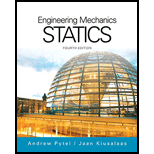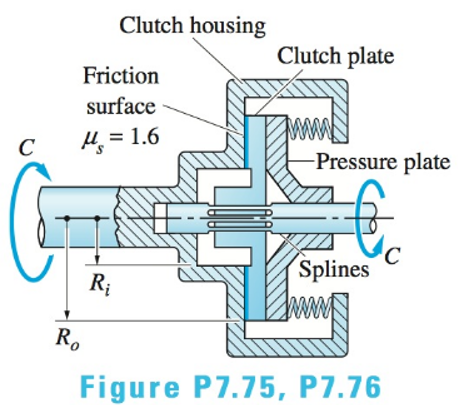
International Edition---engineering Mechanics: Statics, 4th Edition
4th Edition
ISBN: 9781305501607
Author: Andrew Pytel And Jaan Kiusalaas
Publisher: CENGAGE L
expand_more
expand_more
format_list_bulleted
Textbook Question
Chapter 7, Problem 7.76P
The clutch described in Prob. 7.75 is to transmit a torque of

Expert Solution & Answer
Want to see the full answer?
Check out a sample textbook solution
Students have asked these similar questions
(read image)
(read image)
(read me)
Chapter 7 Solutions
International Edition---engineering Mechanics: Statics, 4th Edition
Ch. 7 - Can the two blocks be in equilibrium in the...Ch. 7 - Determine the range of P for which the system of...Ch. 7 - Two identical chairs, each weighing 14 lb, are...Ch. 7 - The two homogeneous bars AB and BC are connected...Ch. 7 - The contact surface between the 36-lb block and...Ch. 7 - The uniform bar AB of weight W is leaning against...Ch. 7 - The center of gravity of the 50-kg spool is at G....Ch. 7 - The brake pads at C and D are pressed against the...Ch. 7 - The 200-lb homogenous cylinder of radius R is...Ch. 7 - The rear-wheel-drive pickup truck, with its center...
Ch. 7 - Solve Prob. 7.10 assuming that the pick-up truck...Ch. 7 - The 2-lb bar is pinned at A and rests on the 4-lb...Ch. 7 - The horizontal force P acts on the rim of the...Ch. 7 - The uniform bar and the homogeneous cylinder each...Ch. 7 - A stepladder consisting of two legs pinned...Ch. 7 - The mass of the unbalanced disk is m, and its...Ch. 7 - The two uniform sheets of plywood, each of length...Ch. 7 - Find the largest value of b/h at which the folding...Ch. 7 - The 3600-lb car with rear Wheel drive is...Ch. 7 - The 3600-lb car with rear wheel drive is...Ch. 7 - The man is trying to push the homogeneous 20-kg...Ch. 7 - A 1.1-kg disk A is placed on the inclined surface....Ch. 7 - The 40-lb spool is suspended from the hanger GA...Ch. 7 - A uniform plank is supported by a fixed support at...Ch. 7 - The uniform bar of weight W is supported by a...Ch. 7 - The uniform plank is initially at rest on the...Ch. 7 - The two homogeneous bars with the weights shown...Ch. 7 - The man pushes the 120-lb homogeneous crate with...Ch. 7 - The 80-kg crate has its center of gravity at G....Ch. 7 - Solve Prob. 7.29 if =0.Ch. 7 - The 120-lb door with its center of gravity at G is...Ch. 7 - Determine the largest force P for which the 16-kg...Ch. 7 - Determine the largest angle for which the...Ch. 7 - The cylinder and the block are connected by a...Ch. 7 - The weight of the cylindrical tank is negligible...Ch. 7 - The coeffient of static friction between the...Ch. 7 - The two homogenous boxes are stacked vertically....Ch. 7 - Two concrete blocks weighing 320 lb each form part...Ch. 7 - Derive the expression for the largest angle ? for...Ch. 7 - The 60-lb plank rests on a frictionless roller at...Ch. 7 - The 2000-lb weight of the trailer is distributed...Ch. 7 - Determine the smallest force P, applied to the...Ch. 7 - The homogenous cylinder of weight W is at rest...Ch. 7 - The uniform bar of length L and weight W is kept...Ch. 7 - The movable bracket of negligible weight is...Ch. 7 - The 200-lb man walks up the inclined plank of...Ch. 7 - Determine the smallest coefficient of static...Ch. 7 - Find the smallest distance d for which the hook...Ch. 7 - Prob. 7.49PCh. 7 - The block of weight W is pulled by the force P...Ch. 7 - The two 200-lb blocks are pushed apart by the 15...Ch. 7 - Determine the smallest horizontal force P that...Ch. 7 - The device shown is used to measure the kinetic...Ch. 7 - The single-threaded screw of the floor jack has a...Ch. 7 - A wedge is used to prop up the 6000-lb block of...Ch. 7 - The square-threaded screw 0f the C-clamp has a...Ch. 7 - The square-threaded screw with a pitch of 10 mm...Ch. 7 - The screw of the carjack has a pitch of 0.1 in....Ch. 7 - How many turns of rope around the capstan are...Ch. 7 - The force P applied to the brake handle enables...Ch. 7 - Prob. 7.61PCh. 7 - The 120-kg block A is suspended from a rope that...Ch. 7 - The leather rein used to fasten the horse to the...Ch. 7 - The 30-lb weight is attached to a rope that runs...Ch. 7 - The rail AB of negligible weight is suspended from...Ch. 7 - The blocks A and B of weights WA and WB are joined...Ch. 7 - The 150-lb weight is attached to a rope that...Ch. 7 - The 50-lb homogeneous bar AB is suspended from a...Ch. 7 - The collar bearing carries the axial load P = 400...Ch. 7 - Solve Sample Problem 7.16 if the contact pressure...Ch. 7 - The 600-lb cable spool is placed on a frictionless...Ch. 7 - Prob. 7.72PCh. 7 - The normal pressure acting on the disk of the...Ch. 7 - Prob. 7.74PCh. 7 - The single-plate clutch transmits the torque C...Ch. 7 - The clutch described in Prob. 7.75 is to transmit...Ch. 7 - The cone clutch transmits the torque C through a...Ch. 7 - The figure shows a steel bar being processed by a...Ch. 7 - The coefficient of rolling resistance between the...Ch. 7 - Prob. 7.80PCh. 7 - Calculate the horizontal force P required to push...Ch. 7 - The uniform pole BC of length L and weight W is...Ch. 7 - The homogeneous bar AB of weight W and length L is...Ch. 7 - Find the smallest angle for which the uniform...Ch. 7 - Prob. 7.85RPCh. 7 - Determine the largest angle for which the uniform...Ch. 7 - Can the uniform bar of weight W remain at rest in...Ch. 7 - The panel of weight W with its center of gravity...Ch. 7 - The woman is trying to move the crate of weight W...Ch. 7 - The screw of the clamp has a square thread of...Ch. 7 - Find the largest clockwise couple C that can be...Ch. 7 - The test specimen AB is placed in the grip of a...Ch. 7 - The coefficient of static friction between the...Ch. 7 - The uniform bars AB and BC are connected with a...
Knowledge Booster
Learn more about
Need a deep-dive on the concept behind this application? Look no further. Learn more about this topic, mechanical-engineering and related others by exploring similar questions and additional content below.Similar questions
- (read me)arrow_forward(read image)arrow_forwardQu. 13 What are the indices for the Direction 2 indicated by vector in the following sketch? Qu. 14 Determine the indices for the direction A and B shown in the following cubic unit cell. please show all work step by step from material engineeringarrow_forward
- The thin-walled open cross section shown is transmitting torque 7. The angle of twist ₁ per unit length of each leg can be determined separately using the equation 01 = 3Ti GLIC 3 where G is the shear modulus, ₁ is the angle of twist per unit length, T is torque, and L is the length of the median line. In this case, i = 1, 2, 3, and T; represents the torque in leg i. Assuming that the angle of twist per unit length for each leg is the same, show that T= Lic³ and Tmaz = G01 Cmax Consider a steel section with Tallow = 12.40 kpsi. C1 2 mm L1 20 mm C2 3 mm L2 30 mm C3 2 mm L3 25 mm Determine the torque transmitted by each leg and the torque transmitted by the entire section. The torque transmitted by the first leg is | N-m. The torque transmitted by the second leg is N-m. The torque transmitted by the third leg is N-m. The torque transmitted by the entire section is N-m.arrow_forwardPlease help, make sure it's to box out and make it clear what answers go where...arrow_forwardThe cylinder floats in the water and oil to the level shown. Determine the weight of the cylinder. (rho)o=910 kg/m^3arrow_forward
arrow_back_ios
SEE MORE QUESTIONS
arrow_forward_ios
Recommended textbooks for you
 International Edition---engineering Mechanics: St...Mechanical EngineeringISBN:9781305501607Author:Andrew Pytel And Jaan KiusalaasPublisher:CENGAGE L
International Edition---engineering Mechanics: St...Mechanical EngineeringISBN:9781305501607Author:Andrew Pytel And Jaan KiusalaasPublisher:CENGAGE L

International Edition---engineering Mechanics: St...
Mechanical Engineering
ISBN:9781305501607
Author:Andrew Pytel And Jaan Kiusalaas
Publisher:CENGAGE L
How to balance a see saw using moments example problem; Author: Engineer4Free;https://www.youtube.com/watch?v=d7tX37j-iHU;License: Standard Youtube License